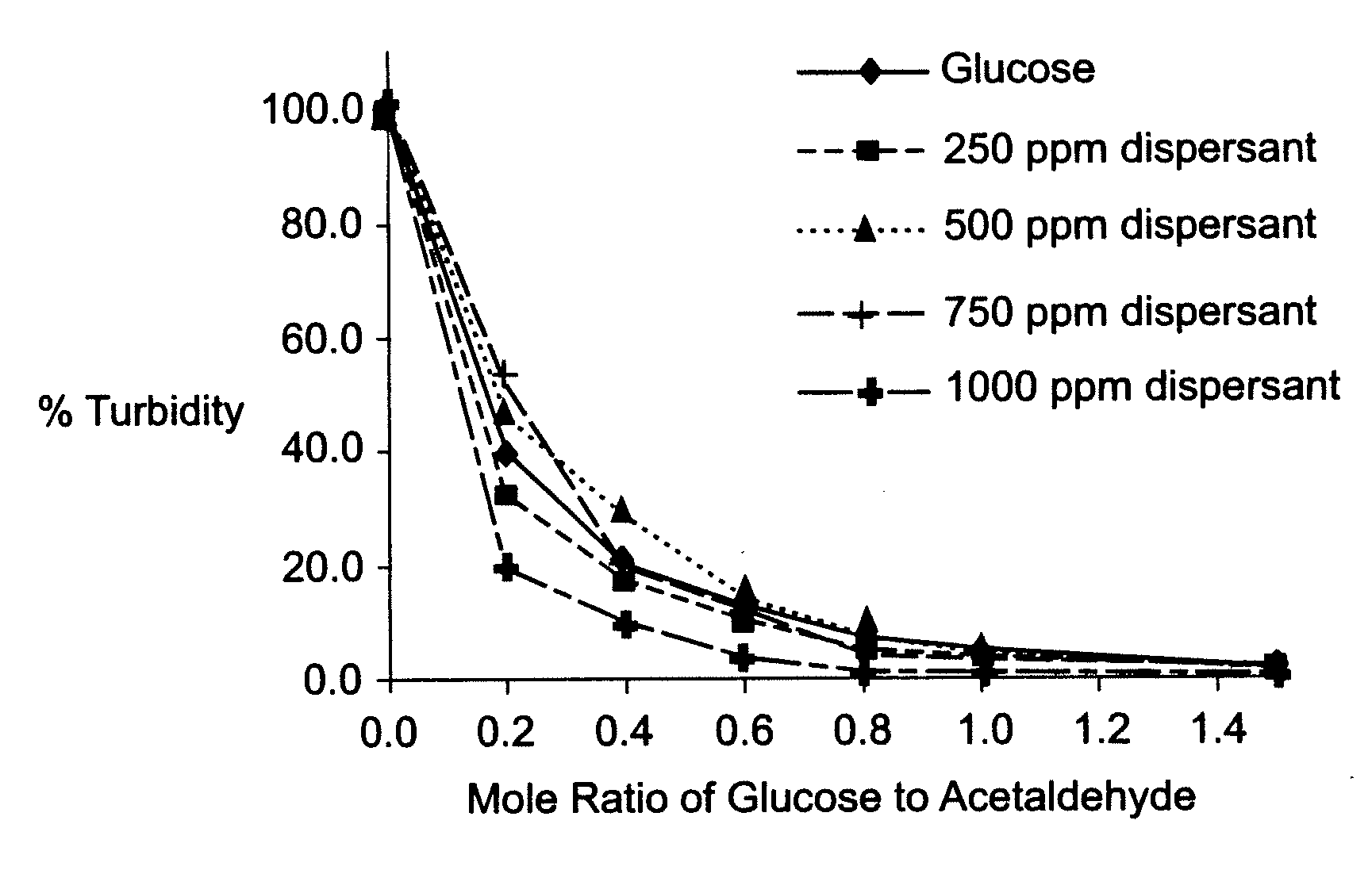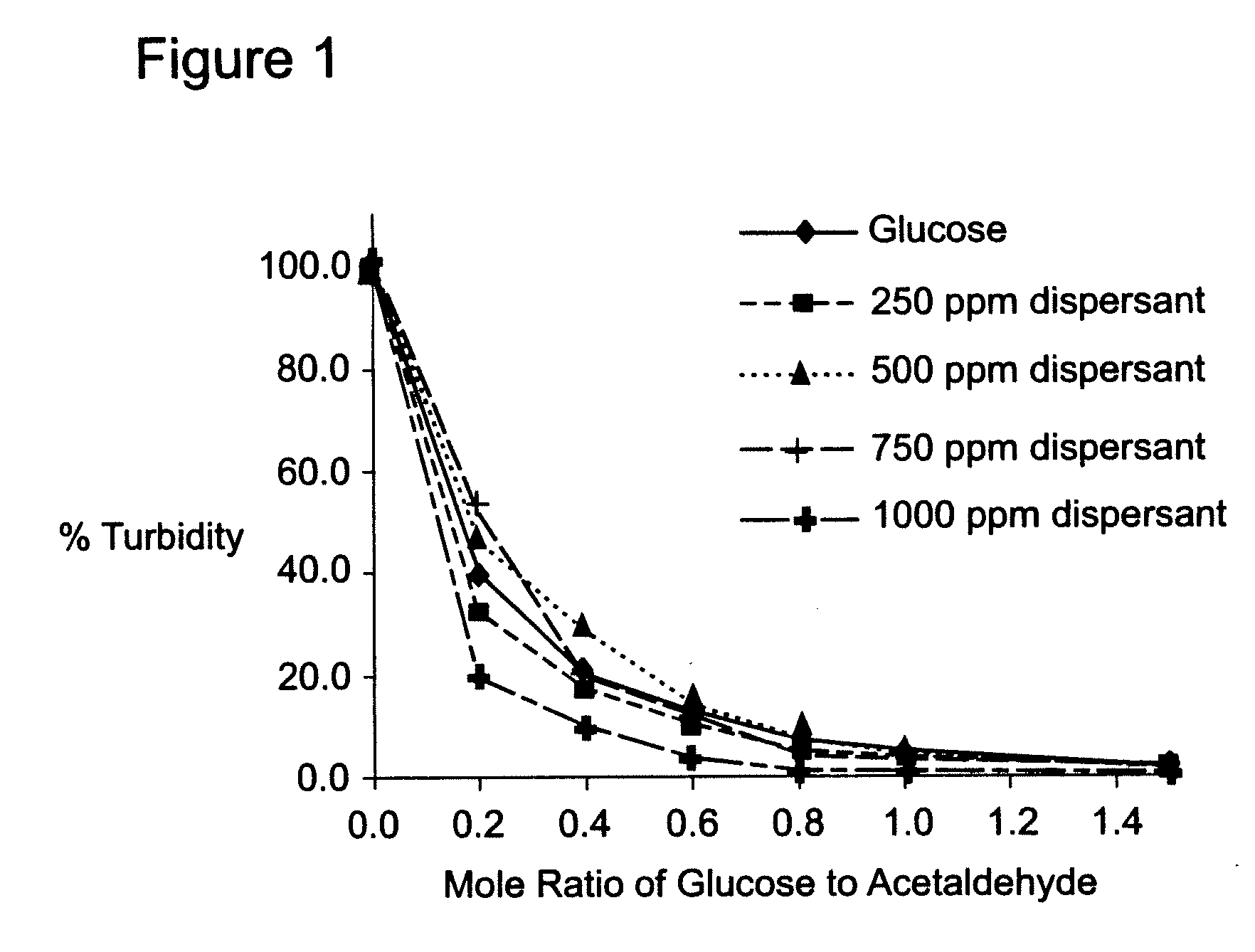Process for inhibiting fouling in hydrocarbon processing
a hydrocarbon and processing technology, applied in the direction of gaseous mixture working up, nuclear elements, nuclear engineering, etc., can solve the problems of premature shutdown of cracking operation, loss of capacity and increased operating costs, and many additives available for petrochemical processes for removing aldehydes that are not environmentally friendly, so as to reduce harmful aldol formation and inhibit fouling
- Summary
- Abstract
- Description
- Claims
- Application Information
AI Technical Summary
Benefits of technology
Problems solved by technology
Method used
Image
Examples
example 1
[0024]Stock solutions of various sugars in deionized water were prepared in concentrations ranging from 0.25M (cellobiose), 0.5M (acetylglucosamine), 1.0M (glucosamine, rhamnose) to 2.0M (glucose, maltose, fructose, sucrose, xylose, arabinose, lyxose, ribose). A set of eight samples for each sugar was prepared by adding aliquots of the Stock sugar solution such that the molar equivalent of sugar with respect to acetaldehyde in each sample bottle was 0, 0.2, 0.4, 0.6, 0.8, 1.0, 1.5, and 3.0, respectively.
[0025]A 16 mL aliquot of a 12.5% sodium hydroxide solution was added to each sample bottle. A stock sugar solution, as prepared above, was added to the sample bottle and a 0.10 mL of a 50% wt / wt Stock solution of acetaldehyde in deionized water was then added (for those sample sets using the more diluted Stock sugar solutions (i.e., <1M), a 13 mL aliquot of 15.4% NaOH solution was used instead of the 12.5% NaOH solution). The volume in the sample bottles was immediately adjusted to 2...
example 2
[0028]From a 2.0 M Stock solution of glucose, five sample sets were prepared such that each set consisted of nine samples containing 0, 0.2, 0.4, 0.6, 0.8, 1.0, 1.5, 3.0, and 5.0 molar equivalents each of glucose with respect to acetaldehyde. A 16 mL aliquot of a 12.5% sodium hydroxide solution was added to each sample bottle. A stock sugar solution was added to each sample bottle and a 0.10 mL of a 50% wt / wt Stock solution of acetaldehyde in deionized water.
[0029]A Stock solution consisting of 10% wt / wt naphthalene sulphonated polymer dispersant in deionized water was prepared using DAXAD® 14C from Hampshire Chemical Corp. All of the sample bottles in one set were dosed with 0.05 mL of the DAXAD® 14C Stock solution. All of the sample bottles in the second set were dosed with 0.10 mL of the DAXAD® 14C Stock solution. All of the sample bottles in the third set were dosed with 0.15 mL of the DAXAD® 14C Stock solution, and all of the sample bottles in the fourth set were dosed with 0.2...
PUM
| Property | Measurement | Unit |
|---|---|---|
| temperature | aaaaa | aaaaa |
| temperature | aaaaa | aaaaa |
| volume | aaaaa | aaaaa |
Abstract
Description
Claims
Application Information
 Login to View More
Login to View More - R&D
- Intellectual Property
- Life Sciences
- Materials
- Tech Scout
- Unparalleled Data Quality
- Higher Quality Content
- 60% Fewer Hallucinations
Browse by: Latest US Patents, China's latest patents, Technical Efficacy Thesaurus, Application Domain, Technology Topic, Popular Technical Reports.
© 2025 PatSnap. All rights reserved.Legal|Privacy policy|Modern Slavery Act Transparency Statement|Sitemap|About US| Contact US: help@patsnap.com


